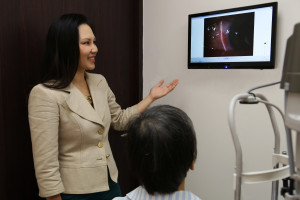Our Services
Managing Myopia

Myopia (short-sightedness) is the most common refractive error in children. It is currently a growing global epidemic and is estimated to affect about half of the global population by 2050. It affects 30% of 5-year old children and up to 80% of 18-year old in Singapore.
Singapore has one of the highest incidence rates of myopia in the world.
Atropine 0.01% is available in our clinic. (more…)
Glaucoma Diagnosis and Treatment

Glaucoma is known as the “Silent Thief of Sight”. Early disease may be unnoticed by the patient as it affects peripheral vision initially. It damages the eye (optic) nerve and may result in irreversible loss of vision. End stage glaucoma may result in tunnel vision or even blindness. Glaucoma is not preventable and early detection is the most ideal.
(more…)
Age-Related Macular Degeneration Screening and Treatment

Age-Related Macular Degeneration (AMD) is a disease of the elderly in which there is progressive loss of retinal cells, resulting in loss of central vision. It is one of the leading cause of blindness affecting those 50 years or older. There are 2 main types of AMD; Dry AMD and Wet AMD
(more…)
Customized Cataract Surgery

Cataracts occur when the natural lens in the eye becomes cloudy.
We provide options for Customized Cataract Surgery.
(more…)
Tearing and Dry Eye Treatment

Tears are a film of moisture in front of our eyes. They lubricate our eyes, and provide a physical and chemically balance environment for our eyes. Dry eyes occurs when our eyes produce too little tears or tears of poor quality to maintain this protective environment. This will lead to longstanding discomfort and decreased vision.
Orbital Conditions Diagnosis and Surgery

The orbit is the area between the eyeball and the bony socket around it. There are many structures in this area. Common problems of the orbit include fractures of the bony wall, tumours of any of the structures, infection and inflammation of the orbit.
Dr. Alicia Claire How Su-Wei




